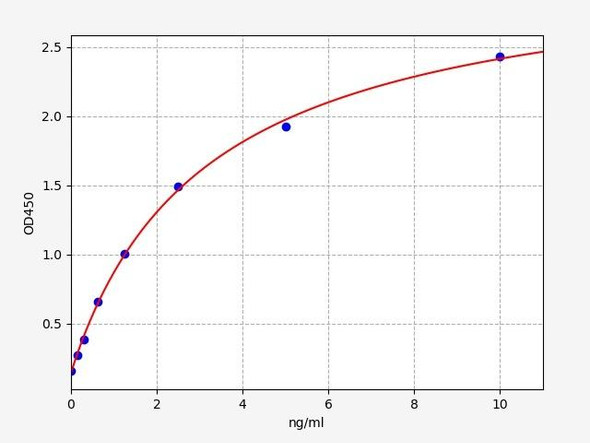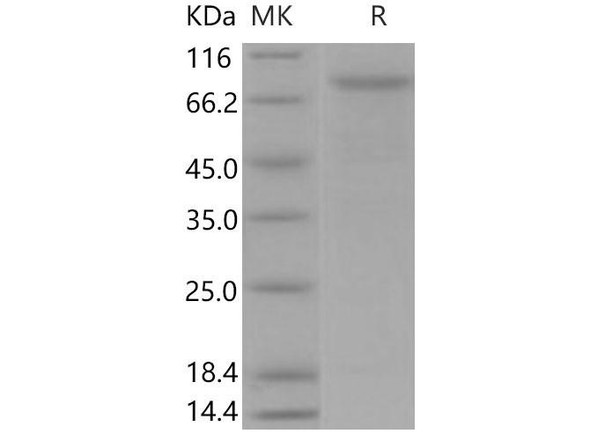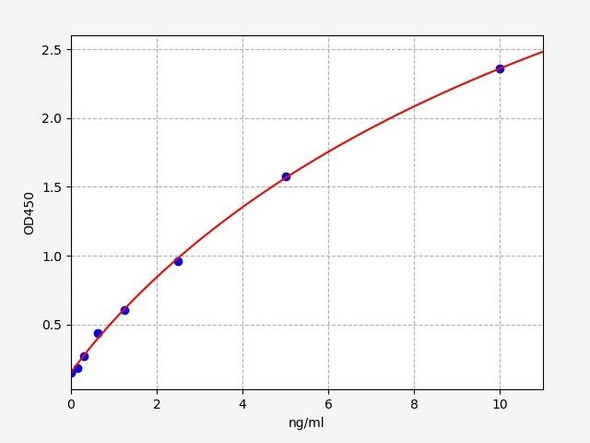Description
Mouse Cadherin-5 (Cdh5) ELISA Kit
The Mouse Cadherin-5 (CDH5) ELISA Kit is specifically designed for the sensitive and accurate detection of Cadherin-5 levels in mouse serum, plasma, and cell culture supernatants. This kit is known for its high specificity and reliability, ensuring precise and reproducible results for a variety of research applications.Cadherin-5, also known as VE-cadherin, is a vital endothelial cell adhesion molecule that plays a crucial role in regulating vascular permeability and angiogenesis. Dysregulation of Cadherin-5 has been associated with various cardiovascular diseases, including atherosclerosis and hypertension, as well as tumor progression and metastasis in cancer.
By measuring Cadherin-5 levels in biological samples, researchers can gain valuable insights into the mechanisms underlying vascular dysfunction and disease progression. The Mouse Cadherin-5 ELISA Kit provides a powerful tool for studying these processes and developing potential therapeutic interventions.
| Product Name: | Mouse Cadherin-5 (Cdh5) ELISA Kit |
| SKU: | MOEB1215 |
| Size: | 96T |
| Target: | Mouse Cadherin-5 (Cdh5) |
| Synonyms: | Vascular endothelial cadherin, VE-cadherin, CD144 |
| Assay Type: | Sandwich |
| Detection Method: | ELISA |
| Reactivity: | Mouse |
| Detection Range: | 0.312-20ng/mL |
| Sensitivity: | 0.16ng/mL |
| Intra CV: | Provided with the Kit |
| Inter CV: | Provided with the Kit |
| Linearity: | Provided with the Kit |
| Recovery: | Provided with the Kit |
| Function: | Cadherins are calcium-dependent cell adhesion proteins. They preferentially interact with themselves in a homophilic manner in connecting cells; cadherins may thus contribute to the sorting of heterogeneous cell types. This cadherin may play an important role in endothelial cell biology through control of the cohesion and organization of the intercellular junctions. Acts in concert with KRIT1 to establish and maintain correct endothelial cell polarity and vascular lumen. These effects are mediated by recruitment and activation of the Par polarity complex and RAP1B. Required for activation of PRKCZ and for localization of phosphorylated PRKCZ, PARD3, TIAM1 and RAP1B to the cell junction. |
| Uniprot: | P55284 |
| Sample Type: | Serum, plasma, tissue homogenates, cell culture supernates and other biological fluids |
| Specificity: | Natural and recombinant mouse Cadherin-5 |
| Sub Unit: | Interacts (via cadherin 5 domain) with PTPRB. Interacts with TRPC4. Interacts with KRIT1 (By similarity). Interacts with PARD3. |
| Subcellular Location: | Cell junction Cell membrane Single-pass type I membrane protein Found at cell-cell boundaries and probably at cell-matrix boundaries. KRIT1 and CDH5 reciprocally regulate their localization to endothelial cell-cell junctions (By similarity). |
| Storage: | Please see kit components below for exact storage details |
| Note: | For research use only |
| UniProt Protein Function: | CDH5: Cadherins are calcium dependent cell adhesion proteins. They preferentially interact with themselves in a homophilic manner in connecting cells; cadherins may thus contribute to the sorting of heterogeneous cell types. This cadherin may play a important role in endothelial cell biology through control of the cohesion and organization of the intercellular junctions. It associates with alpha-catenin forming a link to the cytoskeleton. Acts in concert with KRIT1 to establish and maintain correct endothelial cell polarity and vascular lumen. These effects are mediated by recruitment and activation of the Par polarity complex and RAP1B. Required for activation of PRKCZ and for the localization of phosphorylated PRKCZ, PARD3, TIAM1 and RAP1B to the cell junction. Interacts via cadherin 5 domain with PTPRB. Interacts with TRPC4. Interacts with KRIT1. Endothelial tissues and brain. |
| UniProt Protein Details: | Protein type:Motility/polarity/chemotaxis; Cell adhesion; Membrane protein, integral Cellular Component: adherens junction; cell junction; cell surface; external side of plasma membrane; integral to membrane; intercellular junction; membrane; plasma membrane; tight junction Molecular Function:beta-catenin binding; calcium ion binding; metal ion binding; protein binding; protein phosphatase binding; receptor binding Biological Process: blood vessel maturation; cell adhesion; cell-cell adhesion; homophilic cell adhesion; intercellular junction assembly; negative regulation of cell proliferation; transforming growth factor beta receptor signaling pathway |
| NCBI Summary: | This gene encodes a member of the cadherin family of calcium-dependent glycoproteins that mediate cell adhesion and regulate many morphogenetic events during development. The encoded preproprotein is further processed to generate a mature protein. Mice lacking the encoded protein die in utero due to vascular insufficiency, caused by increased endothelial apoptosis. Multiple distinct genes of the cadherin family, including this gene, are found on chromosome 8. [provided by RefSeq, Oct 2015] |
| UniProt Code: | P55284 |
| NCBI GenInfo Identifier: | 34588132 |
| NCBI Gene ID: | 12562 |
| NCBI Accession: | P55284.2 |
| UniProt Secondary Accession: | P55284,O35542, |
| UniProt Related Accession: | P55284 |
| Molecular Weight: | 87,903 Da |
| NCBI Full Name: | Cadherin-5 |
| NCBI Synonym Full Names: | cadherin 5 |
| NCBI Official Symbol: | Cdh5 |
| NCBI Official Synonym Symbols: | 7B4; Vec; VECD; Cd144; VEcad; VE-Cad; AA408225 |
| NCBI Protein Information: | cadherin-5 |
| UniProt Protein Name: | Cadherin-5 |
| UniProt Synonym Protein Names: | Vascular endothelial cadherin; VE-cadherin; CD_antigen: CD144 |
| Protein Family: | Cadherin |
| UniProt Gene Name: | Cdh5 |
| UniProt Entry Name: | CADH5_MOUSE |
| Component | Quantity (96 Assays) | Storage |
| ELISA Microplate (Dismountable) | 8×12 strips | -20°C |
| Lyophilized Standard | 2 | -20°C |
| Sample Diluent | 20ml | -20°C |
| Assay Diluent A | 10mL | -20°C |
| Assay Diluent B | 10mL | -20°C |
| Detection Reagent A | 120µL | -20°C |
| Detection Reagent B | 120µL | -20°C |
| Wash Buffer | 30mL | 4°C |
| Substrate | 10mL | 4°C |
| Stop Solution | 10mL | 4°C |
| Plate Sealer | 5 | - |
Other materials and equipment required:
- Microplate reader with 450 nm wavelength filter
- Multichannel Pipette, Pipette, microcentrifuge tubes and disposable pipette tips
- Incubator
- Deionized or distilled water
- Absorbent paper
- Buffer resevoir
*Note: The below protocol is a sample protocol. Protocols are specific to each batch/lot. For the correct instructions please follow the protocol included in your kit.
Allow all reagents to reach room temperature (Please do not dissolve the reagents at 37°C directly). All the reagents should be mixed thoroughly by gently swirling before pipetting. Avoid foaming. Keep appropriate numbers of strips for 1 experiment and remove extra strips from microtiter plate. Removed strips should be resealed and stored at -20°C until the kits expiry date. Prepare all reagents, working standards and samples as directed in the previous sections. Please predict the concentration before assaying. If values for these are not within the range of the standard curve, users must determine the optimal sample dilutions for their experiments. We recommend running all samples in duplicate.
| Step | |
| 1. | Add Sample: Add 100µL of Standard, Blank, or Sample per well. The blank well is added with Sample diluent. Solutions are added to the bottom of micro ELISA plate well, avoid inside wall touching and foaming as possible. Mix it gently. Cover the plate with sealer we provided. Incubate for 120 minutes at 37°C. |
| 2. | Remove the liquid from each well, don't wash. Add 100µL of Detection Reagent A working solution to each well. Cover with the Plate sealer. Gently tap the plate to ensure thorough mixing. Incubate for 1 hour at 37°C. Note: if Detection Reagent A appears cloudy warm to room temperature until solution is uniform. |
| 3. | Aspirate each well and wash, repeating the process three times. Wash by filling each well with Wash Buffer (approximately 400µL) (a squirt bottle, multi-channel pipette,manifold dispenser or automated washer are needed). Complete removal of liquid at each step is essential. After the last wash, completely remove remaining Wash Buffer by aspirating or decanting. Invert the plate and pat it against thick clean absorbent paper. |
| 4. | Add 100µL of Detection Reagent B working solution to each well. Cover with the Plate sealer. Incubate for 60 minutes at 37°C. |
| 5. | Repeat the wash process for five times as conducted in step 3. |
| 6. | Add 90µL of Substrate Solution to each well. Cover with a new Plate sealer and incubate for 10-20 minutes at 37°C. Protect the plate from light. The reaction time can be shortened or extended according to the actual color change, but this should not exceed more than 30 minutes. When apparent gradient appears in standard wells, user should terminatethe reaction. |
| 7. | Add 50µL of Stop Solution to each well. If color change does not appear uniform, gently tap the plate to ensure thorough mixing. |
| 8. | Determine the optical density (OD value) of each well at once, using a micro-plate reader set to 450 nm. User should open the micro-plate reader in advance, preheat the instrument, and set the testing parameters. |
| 9. | After experiment, store all reagents according to the specified storage temperature respectively until their expiry. |
When carrying out an ELISA assay it is important to prepare your samples in order to achieve the best possible results. Below we have a list of procedures for the preparation of samples for different sample types.
| Sample Type | Protocol |
| Serum | If using serum separator tubes, allow samples to clot for 30 minutes at room temperature. Centrifuge for 10 minutes at 1,000x g. Collect the serum fraction and assay promptly or aliquot and store the samples at -80°C. Avoid multiple freeze-thaw cycles. If serum separator tubes are not being used, allow samples to clot overnight at 2-8°C. Centrifuge for 10 minutes at 1,000x g. Remove serum and assay promptly or aliquot and store the samples at -80°C. Avoid multiple freeze-thaw cycles. |
| Plasma | Collect plasma using EDTA or heparin as an anticoagulant. Centrifuge samples at 4°C for 15 mins at 1000 × g within 30 mins of collection. Collect the plasma fraction and assay promptly or aliquot and store the samples at -80°C. Avoid multiple freeze-thaw cycles. Note: Over haemolysed samples are not suitable for use with this kit. |
| Urine & Cerebrospinal Fluid | Collect the urine (mid-stream) in a sterile container, centrifuge for 20 mins at 2000-3000 rpm. Remove supernatant and assay immediately. If any precipitation is detected, repeat the centrifugation step. A similar protocol can be used for cerebrospinal fluid. |
| Cell culture supernatant | Collect the cell culture media by pipette, followed by centrifugation at 4°C for 20 mins at 1500 rpm. Collect the clear supernatant and assay immediately. |
| Cell lysates | Solubilize cells in lysis buffer and allow to sit on ice for 30 minutes. Centrifuge tubes at 14,000 x g for 5 minutes to remove insoluble material. Aliquot the supernatant into a new tube and discard the remaining whole cell extract. Quantify total protein concentration using a total protein assay. Assay immediately or aliquot and store at ≤ -20 °C. |
| Tissue homogenates | The preparation of tissue homogenates will vary depending upon tissue type. Rinse tissue with 1X PBS to remove excess blood & homogenize in 20ml of 1X PBS (including protease inhibitors) and store overnight at ≤ -20°C. Two freeze-thaw cycles are required to break the cell membranes. To further disrupt the cell membranes you can sonicate the samples. Centrifuge homogenates for 5 mins at 5000xg. Remove the supernatant and assay immediately or aliquot and store at -20°C or -80°C. |
| Tissue lysates | Rinse tissue with PBS, cut into 1-2 mm pieces, and homogenize with a tissue homogenizer in PBS. Add an equal volume of RIPA buffer containing protease inhibitors and lyse tissues at room temperature for 30 minutes with gentle agitation. Centrifuge to remove debris. Quantify total protein concentration using a total protein assay. Assay immediately or aliquot and store at ≤ -20 °C. |
| Breast Milk | Collect milk samples and centrifuge at 10,000 x g for 60 min at 4°C. Aliquot the supernatant and assay. For long term use, store samples at -80°C. Minimize freeze/thaw cycles. |










